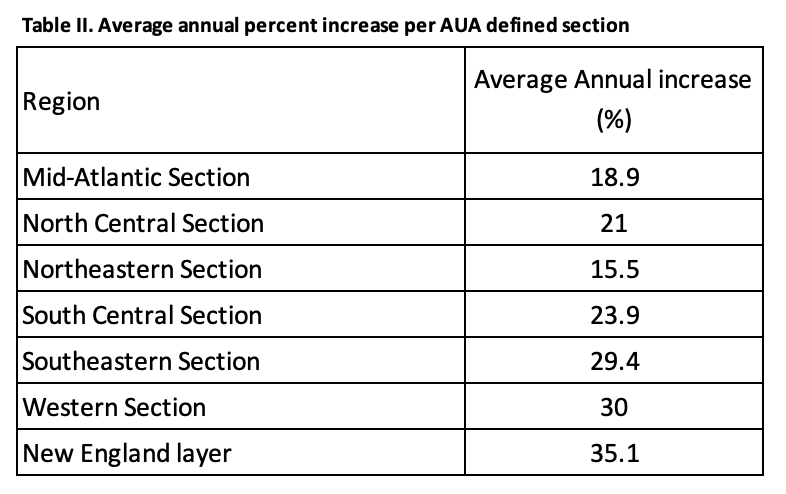Back
Poster, Podium & Video Sessions
Moderated Poster
MP26: Stone Disease: Epidemiology & Evaluation I
MP26-08: Prevalence of symptomatic pediatric stone disease at the emergency department – A review of National PHIS database
Saturday, May 14, 2022
10:30 AM – 11:45 AM
Location: Room 225
Joshua Collingwood, Cole Arnold*, Dothan, AL, Shelby Mize, Kalamazoo, MI, Pankaj Dangle, Birmingham, AL
- CA
Cole Sutton Arnold, BS
Alabama College of Osteopathic Medicine
Poster Presenter(s)
Introduction: Symptomatic pediatric nephrolithiasis has increased in recent decades. Increased pediatric nephrolithiasis presentation in the emergency department is recognized, yet statistical data is sparse indicating geographic and seasonal influence. This study aims to identify trends in symptomatic ED pediatric nephrolithiasis presentation while assessing the prevalence of symptomatic stone disease across the US considering national and seasonal variation.
Methods: Following IRB approval, data was obtained from the Pediatric Health Information System (PHIS) to assess Emergency Department (ED) pediatric nephrolithiasis between 2004 and 2021 at a national level.
Inclusion criteria included all pediatric symptomatic nephrolithiasis presentations to ED at any of the 47 PHIS locations between 2004 and 2021. To analyze symptomatic ED pediatric nephrolithiasis presentations across six geographic locations throughout the United States, Kruskal-Wallis was utilized to assess for the existence of a monotonic trend on a yearly and seasonal scale and Mann-Kendall test to assess directionality; Mann-Whitney U test was employed to account for variations between yearly and seasonal distributions. Additionally, to illustrate the changing rate of nephrolithiasis annually, a prevalence map was developed.
Results: PHIS data included 21,607 symptomatic ED pediatric nephrolithiasis presentations (male 44.8%, female 55.2%). An increasing trend in ED pediatric nephrolithiasis presentations across all 6 geographic (AUA) defined sections and Mann-Kendall determined trend directionality to be increasing (P=0.003). Accordingly, we determined a marked increase of 22.8% average annual growth across all AUA defined sections. Post hoc comparisons via Mann-Whitney U test determine no statistical difference in seasonal pediatric nephrolithiasis presentations between sections.
Conclusions: On a national level, the prevalence of pediatric nephrolithiasis is increasing by an average 22.8% annually. Although statistical analysis determined no significant difference in seasonal variance between geographic locations, the rising prevalence of symptomatic ED presentations indicates a non-seasonal risk factor; this warrants further consideration.
Source of Funding: N/A

Methods: Following IRB approval, data was obtained from the Pediatric Health Information System (PHIS) to assess Emergency Department (ED) pediatric nephrolithiasis between 2004 and 2021 at a national level.
Inclusion criteria included all pediatric symptomatic nephrolithiasis presentations to ED at any of the 47 PHIS locations between 2004 and 2021. To analyze symptomatic ED pediatric nephrolithiasis presentations across six geographic locations throughout the United States, Kruskal-Wallis was utilized to assess for the existence of a monotonic trend on a yearly and seasonal scale and Mann-Kendall test to assess directionality; Mann-Whitney U test was employed to account for variations between yearly and seasonal distributions. Additionally, to illustrate the changing rate of nephrolithiasis annually, a prevalence map was developed.
Results: PHIS data included 21,607 symptomatic ED pediatric nephrolithiasis presentations (male 44.8%, female 55.2%). An increasing trend in ED pediatric nephrolithiasis presentations across all 6 geographic (AUA) defined sections and Mann-Kendall determined trend directionality to be increasing (P=0.003). Accordingly, we determined a marked increase of 22.8% average annual growth across all AUA defined sections. Post hoc comparisons via Mann-Whitney U test determine no statistical difference in seasonal pediatric nephrolithiasis presentations between sections.
Conclusions: On a national level, the prevalence of pediatric nephrolithiasis is increasing by an average 22.8% annually. Although statistical analysis determined no significant difference in seasonal variance between geographic locations, the rising prevalence of symptomatic ED presentations indicates a non-seasonal risk factor; this warrants further consideration.
Source of Funding: N/A


.jpg)
.jpg)